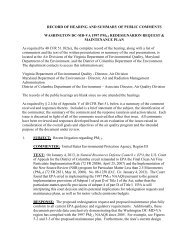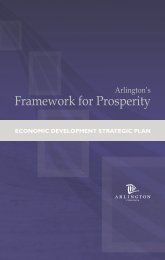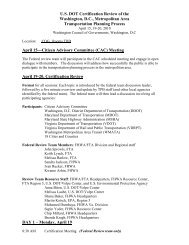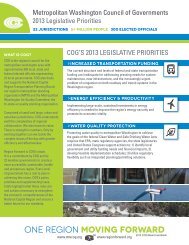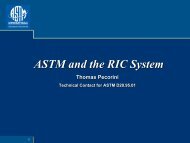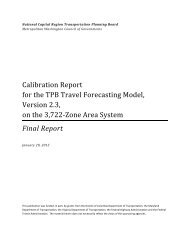PTI Local Government Energy Assurance Guidelines - Metropolitan ...
PTI Local Government Energy Assurance Guidelines - Metropolitan ...
PTI Local Government Energy Assurance Guidelines - Metropolitan ...
You also want an ePaper? Increase the reach of your titles
YUMPU automatically turns print PDFs into web optimized ePapers that Google loves.
3. Economic impact information: This information assesses the economic consequences of the energy<br />
disruption.<br />
•y<br />
•y<br />
•y<br />
How much money will this cost the community?<br />
Will the community see a spike in energy costs?<br />
What demand-reduction strategies are most effective and appropriate?<br />
4. Recovery planning information: This assessment determines short- and long-range recovery efforts.<br />
•y<br />
•y<br />
•y<br />
Are there energy systems (electricity, natural gas infrastructure, etc.) that are shut down or delayed due<br />
to the energy emergency? How will this impact community productivity?<br />
What services need to be restored first? (See section 3.8.)<br />
Does the energy emergency leave a lasting hazard in the community (chemical leaks, water<br />
contamination, etc.)?<br />
It may be necessary to coordinate or leverage public and private-sector partnerships to acquire key data before<br />
moving forward in stabilizing the community. This is the time to tap already-established contacts in the public and<br />
private sector that may have helped to develop the EAP, other emergency response plans, continuity of operations<br />
plans and risk communications plans before the energy emergency occurred. At the onset of an emergency, these<br />
partnerships should be immediately leveraged to help assess the nature of the emergency and to help manage the<br />
developing situation.<br />
2.6 Understanding the Impacts of New and Alternative Technologies on <strong>Energy</strong><br />
<strong>Assurance</strong> Planning<br />
Technology is a crucial, powerful ally in any energy assurance effort. This section addresses three areas regarding the<br />
role of new and alternative energy technologies in local energy assurance planning efforts:<br />
2.6.1. The Smart Grid<br />
2.6.2. Renewable <strong>Energy</strong> Technologies<br />
2.6.3. <strong>Energy</strong> Efficiency/Distributed Generation and <strong>Energy</strong> <strong>Assurance</strong><br />
2.6.1 The Smart Grid<br />
The term smart grid refers to a modernization of the electricity delivery system that monitors, protects and<br />
automatically optimizes the operation of its interconnected elements—from central and distributed generators<br />
through the high-voltage network and distribution system, to industrial users and commercial building automation<br />
systems, to energy storage installations, and to residential consumers and their thermostats, electric vehicles,<br />
appliances, and other household devices. Some find it easier to grasp the concept of the smart grid as the “Internet<br />
for energy”—with hardware and software connected via intelligent communications systems.<br />
The smart grid is generally characterized by a two-way flow of electricity and the data necessary to create an<br />
automated, widely distributed energy delivery network. It incorporates into the grid the benefits of distributed<br />
computing and communications to deliver real-time information, enabling operators to understand and optimize<br />
their systems and facilitating the ability of intelligent devices to take action based on that information. Smart grid<br />
technologies include advanced sensors, system communication infrastructure, advanced power delivery equipment<br />
and controls, and advanced modeling and simulation techniques.<br />
<strong>Local</strong> <strong>Government</strong> <strong>Energy</strong> <strong>Assurance</strong> <strong>Guidelines</strong> – Version 2.0 | 15



